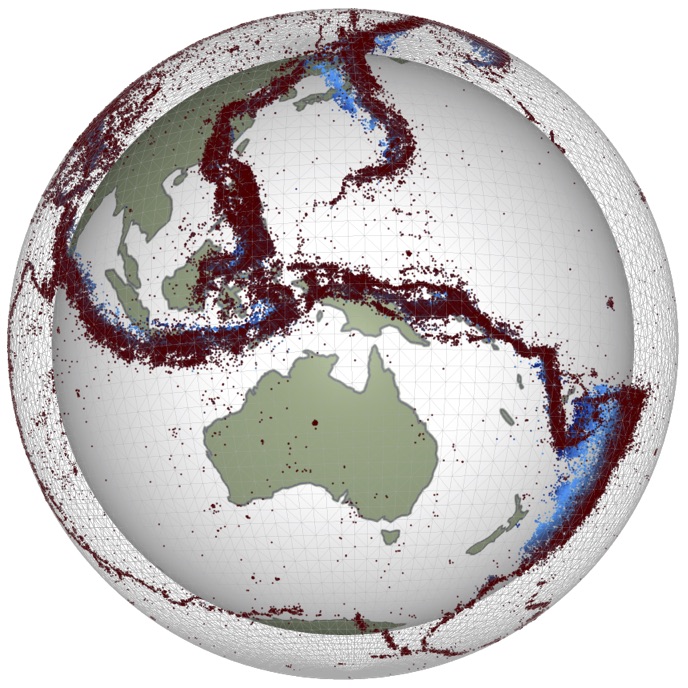Shear bands around a circular inclusion in a simple shear flow#
No slip conditions
# to fix trame issue
import nest_asyncio
nest_asyncio.apply()
expt_name = "ShearBand"
import petsc4py
import underworld3 as uw
import numpy as np
import meshio, pygmsh
# Mesh a 2D pipe with a circular hole
csize = 0.075
csize_circle = 0.025
res = csize_circle
width = 3.0
height = 1.0
radius = 0.1
if uw.mpi.rank == 0:
# Generate local mesh on boss process
with pygmsh.geo.Geometry() as geom:
geom.characteristic_length_max = csize
inclusion = geom.add_circle(
(0.0, 0.0, 0.0), radius, make_surface=False, mesh_size=csize_circle
)
domain = geom.add_rectangle(
xmin=-width / 2,
ymin=-height / 2,
xmax=width / 2,
ymax=height / 2,
z=0,
holes=[inclusion],
mesh_size=csize,
)
geom.add_physical(domain.surface.curve_loop.curves[0], label="bottom")
geom.add_physical(domain.surface.curve_loop.curves[1], label="right")
geom.add_physical(domain.surface.curve_loop.curves[2], label="top")
geom.add_physical(domain.surface.curve_loop.curves[3], label="left")
geom.add_physical(inclusion.curve_loop.curves, label="inclusion")
geom.add_physical(domain.surface, label="Elements")
geom.generate_mesh(dim=2, verbose=False)
geom.save_geometry("tmp_shear_inclusion.msh")
mesh1 = uw.discretisation.Mesh("tmp_shear_inclusion.msh", simplex=True)
# Define some functions on the mesh
import sympy
# radius_fn = sympy.sqrt(mesh1.rvec.dot(mesh1.rvec)) # normalise by outer radius if not 1.0
# unit_rvec = mesh1.rvec / (1.0e-10+radius_fn)
# Some useful coordinate stuff
x, y = mesh1.X
# relative to the centre of the inclusion
r = sympy.sqrt(x**2 + y**2)
th = sympy.atan2(y, x)
# need a unit_r_vec equivalent
inclusion_rvec = mesh1.X
inclusion_unit_rvec = inclusion_rvec / inclusion_rvec.dot(inclusion_rvec)
inclusion_unit_rvec = mesh1.vector.to_matrix(inclusion_unit_rvec)
v_soln = uw.discretisation.MeshVariable("U", mesh1, mesh1.dim, degree=2)
p_soln = uw.discretisation.MeshVariable("P", mesh1, 1, degree=1, continuous=False)
p_cont = uw.discretisation.MeshVariable("Pc", mesh1, 1, degree=1, continuous=True)
p_null = uw.discretisation.MeshVariable(r"P2", mesh1, 1, degree=1, continuous=True)
vorticity = uw.discretisation.MeshVariable("omega", mesh1, 1, degree=1)
strain_rate_inv2 = uw.discretisation.MeshVariable("eps", mesh1, 1, degree=1)
dev_stress_inv2 = uw.discretisation.MeshVariable("tau", mesh1, 1, degree=1)
node_viscosity = uw.discretisation.MeshVariable("eta", mesh1, 1, degree=1)
r_inc = uw.discretisation.MeshVariable("R", mesh1, 1, degree=1)
# Create NS object
stokes = uw.systems.Stokes(
mesh1,
velocityField=v_soln,
pressureField=p_soln,
verbose=False,
solver_name="stokes",
)
stokes.constitutive_model = uw.constitutive_models.ViscousFlowModel
stokes.constitutive_model.Parameters.viscosity = 1
stokes.saddle_preconditioner = 1 / stokes.constitutive_model.Parameters.viscosity
stokes.penalty = 0.0
stokes.petsc_options["ksp_monitor"] = None
stokes.petsc_options["snes_atol"] = 0.001
nodal_strain_rate_inv2 = uw.systems.Projection(
mesh1, strain_rate_inv2, solver_name="edot_II"
)
nodal_strain_rate_inv2.add_dirichlet_bc(1.0, "top", 0)
nodal_strain_rate_inv2.add_dirichlet_bc(1.0, "bottom", 0)
nodal_strain_rate_inv2.uw_function = stokes.Unknowns.Einv2
nodal_strain_rate_inv2.smoothing = 1.0e-3
nodal_strain_rate_inv2.petsc_options.delValue("ksp_monitor")
nodal_tau_inv2 = uw.systems.Projection(mesh1, dev_stress_inv2, solver_name="stress_II")
S = stokes.stress_deviator
nodal_tau_inv2.uw_function = (
sympy.simplify(sympy.sqrt(((S**2).trace()) / 2)) - p_soln.sym[0]
)
nodal_tau_inv2.smoothing = 1.0e-3
nodal_tau_inv2.petsc_options.delValue("ksp_monitor")
nodal_visc_calc = uw.systems.Projection(mesh1, node_viscosity, solver_name="visc")
nodal_visc_calc.uw_function = stokes.constitutive_model.Parameters.viscosity
nodal_visc_calc.smoothing = 1.0e-3
nodal_visc_calc.petsc_options.delValue("ksp_monitor")
# nodal_pres_calc = uw.systems.Projection(mesh1, p_cont, solver_name="pres")
# nodal_pres_calc.uw_function = p_soln.sym[0]
# nodal_pres_calc.smoothing = 1.0e-3
# nodal_pres_calc.petsc_options.delValue("ksp_monitor")
# Set solve options here (or remove default values
# stokes.petsc_options.getAll()
# Constant visc
stokes.penalty = 0.0
stokes.bodyforce = 1.0e-32 * mesh1.CoordinateSystem.unit_e_1
hw = 1000.0 / res
surface_defn_fn = sympy.exp(-(((r - radius) / radius) ** 2) * hw)
# stokes.bodyforce -= 1.0e6 * surface_defn_fn * v_soln.sym.dot(inclusion_unit_rvec) * inclusion_unit_rvec
# Velocity boundary conditions
stokes.add_dirichlet_bc((0.0, 0.0), "inclusion", (0, 1))
stokes.add_dirichlet_bc((1.0, 0.0), "top", (0, 1))
stokes.add_dirichlet_bc((-1.0, 0.0), "bottom", (0, 1))
stokes.add_dirichlet_bc(0.0, "left", 1)
stokes.add_dirichlet_bc(0.0, "right", 1)
# linear solve first
stokes.solve()
# Approach the required non-linear value by gradually adjusting the parameters
steps = 8
for i in range(steps):
mu = 0.5
C = 2.5 + (steps - i) * 0.33
print(f"Mu - {mu}, C = {C}")
tau_y = sympy.Max(C + mu * stokes.p.sym[0], 0.1)
viscosity = sympy.Min(tau_y / (2 * stokes.Unknowns.Einv2 + 0.01), 1.0)
# viscosity = 100 * (0.01 + stokes._Einv2)
stokes.constitutive_model.Parameters.viscosity = viscosity
stokes.saddle_preconditioner = 1 / viscosity
stokes.solve(zero_init_guess=False)
nodal_tau_inv2.uw_function = (
stokes.constitutive_model.Parameters.viscosity * stokes.Unknowns.Einv2
)
nodal_tau_inv2.solve()
nodal_visc_calc.uw_function = stokes.constitutive_model.Parameters.viscosity
nodal_visc_calc.solve()
nodal_strain_rate_inv2.solve()
# nodal_pres_calc.solve()
with mesh1.access():
print(v_soln.data)
# check the mesh if in a notebook / serial
if uw.mpi.size == 1:
import pyvista as pv
import underworld3.visualisation as vis
pvmesh = vis.mesh_to_pv_mesh(mesh1)
pvmesh.point_data["P"] = vis.scalar_fn_to_pv_points(pvmesh, p_cont.sym)
pvmesh.point_data["Edot"] = vis.scalar_fn_to_pv_points(pvmesh, strain_rate_inv2.sym)
pvmesh.point_data["Visc"] = vis.scalar_fn_to_pv_points(pvmesh, node_viscosity.sym)
pvmesh.point_data["Str"] = vis.scalar_fn_to_pv_points(pvmesh, dev_stress_inv2.sym)
pvmesh.point_data["V"] = vis.vector_fn_to_pv_points(pvmesh, v_soln.sym)
pvmesh.point_data["Vmag"] = vis.scalar_fn_to_pv_points(pvmesh, v_soln.sym.dot(v_soln.sym))
velocity_points = vis.meshVariable_to_pv_cloud(v_soln)
velocity_points.point_data["V"] = vis.vector_fn_to_pv_points(velocity_points, v_soln.sym)
# point sources at cell centres
subsample = 10
points = np.zeros((mesh1._centroids[::subsample].shape[0], 3))
points[:, 0] = mesh1._centroids[::subsample, 0]
points[:, 1] = mesh1._centroids[::subsample, 1]
point_cloud = pv.PolyData(points)
pvstream = pvmesh.streamlines_from_source(
point_cloud, vectors="V", integration_direction="both", max_steps=100
)
pl = pv.Plotter(window_size=(1000, 500))
pl.add_arrows(velocity_points.points, velocity_points.point_data["V"], mag=0.1, opacity=0.75)
pl.camera_position = "xy"
pl.add_mesh(
pvmesh,
cmap="coolwarm",
edge_color="Grey",
show_edges=True,
clim=[1.0, 2.0],
scalars="Edot",
use_transparency=False,
opacity=1.0,
)
# pl.add_mesh(pvmesh,'Black', 'wireframe', opacity=0.75)
pl.add_mesh(pvstream)
# pl.remove_scalar_bar("mag")
pl.show()
pvmesh.point_data["Visc"].min(), pvmesh.point_data["Visc"].max()
pvmesh.point_data["P"].min(), pvmesh.point_data["P"].max() # cf 4.26
pvmesh.point_data["Str"].min(), pvmesh.point_data["Str"].max()
pvmesh.point_data["Edot"].min(), pvmesh.point_data["Edot"].max()
pvmesh.point_data["V"].min(), pvmesh.point_data["V"].max()

